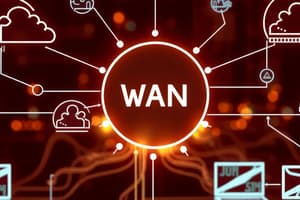Podcast
Questions and Answers
What is the primary focus of Chapter 6?
What is the primary focus of Chapter 6?
- Exploration of Ethernet specifications
- Overview of physical network topologies
- Description of networking media and cable types
- Introduction to Internet Protocol (IP) (correct)
Which layer of the OSI model is NOT covered in Chapter 2?
Which layer of the OSI model is NOT covered in Chapter 2?
- Transport
- Application
- Network (correct)
- Physical
What type of addressing is discussed in Chapter 7?
What type of addressing is discussed in Chapter 7?
- Public versus private addressing (correct)
- Static and dynamic addressing
- Local and remote addressing
- IP version 4 versus version 6
Which device types are described in Chapter 5?
Which device types are described in Chapter 5?
What concept does Chapter 4 primarily address?
What concept does Chapter 4 primarily address?
In the context of networking, what is DHCP as mentioned in Chapter 7?
In the context of networking, what is DHCP as mentioned in Chapter 7?
Which physical network topology is NOT typically covered in introductory courses?
Which physical network topology is NOT typically covered in introductory courses?
Which aspect of the OSI model is NOT typically emphasized in networking introduction courses?
Which aspect of the OSI model is NOT typically emphasized in networking introduction courses?
Which layer of the DoD model is responsible for process/application protocols?
Which layer of the DoD model is responsible for process/application protocols?
What is the primary function of the Host-to-Host Layer in the TCP/IP model?
What is the primary function of the Host-to-Host Layer in the TCP/IP model?
Which protocol operates at the Internet Layer of the TCP/IP model?
Which protocol operates at the Internet Layer of the TCP/IP model?
What is encapsulation in the context of networking?
What is encapsulation in the context of networking?
Which protocol is used for sending emails over the Internet?
Which protocol is used for sending emails over the Internet?
Which of the following is a characteristic of TCP?
Which of the following is a characteristic of TCP?
What does DHCP stand for, and what is its purpose?
What does DHCP stand for, and what is its purpose?
In which layer of the OSI model is the TCP/UDP protocol functionality categorized?
In which layer of the OSI model is the TCP/UDP protocol functionality categorized?
What is the main purpose of IP addressing in networking?
What is the main purpose of IP addressing in networking?
What defines the term 'subnetting' in IP networking?
What defines the term 'subnetting' in IP networking?
What distinguishes IPv6 from its predecessor in terms of address capacity?
What distinguishes IPv6 from its predecessor in terms of address capacity?
Which of the following are types of Network Address Translation (NAT)?
Which of the following are types of Network Address Translation (NAT)?
What type of addressing does Classless Inter-Domain Routing (CIDR) use?
What type of addressing does Classless Inter-Domain Routing (CIDR) use?
In the context of IP routing, what is the purpose of administrative distance?
In the context of IP routing, what is the purpose of administrative distance?
Which routing protocol is classified as a Link-State routing protocol?
Which routing protocol is classified as a Link-State routing protocol?
What is a key characteristic of Distance-Vector routing protocols?
What is a key characteristic of Distance-Vector routing protocols?
Which of the following best describes the purpose of subnet masks?
Which of the following best describes the purpose of subnet masks?
What is the primary function of Network Address Translation (NAT)?
What is the primary function of Network Address Translation (NAT)?
What is the significance of routing protocols in networking?
What is the significance of routing protocols in networking?
Which of the following statements about IPv6 routing protocols is correct?
Which of the following statements about IPv6 routing protocols is correct?
Flashcards are hidden until you start studying
Study Notes
Local Area Networks (LAN) and Components
- LANs enable communication among computers in a small geographical area.
- Common components include switches, routers, and wireless access points.
- VLANs allow network segmentation without physical separation.
Network Types
- WANs connect multiple LANs over longer distances, utilizing public or private networks.
- VPNs provide secure remote access by encrypting data between the user and the VPN server.
Network Architecture
- Peer-to-Peer (P2P) networks allow direct communication among devices without a central server.
- Client/Server architecture relies on dedicated servers to manage resources and services.
Physical Network Topologies
- Bus Topology connects all devices on a single cable, simple but limited by distance and performance.
- Star Topology has all devices connected to a central hub, offering better performance and easier troubleshooting.
- Ring Topology connects devices in a circular pathway, where data travels in one direction.
- Mesh Topology provides multiple pathways for data, ensuring reliability and redundancy.
- Point-to-Point Topology involves a direct link between two devices, ideal for straightforward connections.
- Point-to-Multipoint Topology connects one device to multiple endpoints, useful in various scenarios.
- Hybrid Topology combines different topologies to suit specific network needs.
Topology Selection
- Choosing the right topology depends on factors like scale, cost, and performance requirements.
Encapsulation and OSI Model
- Encapsulation is the method of encapsulating data into appropriate protocol data units.
- The OSI model consists of seven layers: Application, Presentation, Session, Transport, Network, Data Link, and Physical, each serving specific functions.
Networking Materials and Standards
- Coaxial, twisted-pair, and fiber-optic cables are common physical media for networking.
- Cable properties include transmission speeds, distance limitations, duplex modes, noise immunity, and frequency range.
- Wiring standards, such as 568A and 568B, ensure consistency in cable installation.
Current Ethernet Specifications
- Ethernet operates on a CSMA/CD protocol to manage data collisions.
- Supports both half-duplex and full-duplex communication modes.
- Ethernet frames are crucial for data transfer, containing source and destination addresses.
Networking Devices
- Common devices include hubs, repeaters, modems, NICs, routers, and firewalls, each serving different roles in network communication.
- Specialized devices like load balancers and IDS/IPS enhance network efficiency and security.
Internet Protocol (IP)
- TCP/IP model breaks down into multiple layers, facilitating diverse communication protocols.
- Data encapsulation standards allow for formatting data for transmission across networks.
IP Addressing
- Hierarchical IP addressing includes unique identifiers for network and device locations.
- IPv4 is transitioning to IPv6 to accommodate increasing internet-connected devices, addressing the limitations of IPv4.### Introduction to Networks
- Defines a network and outlines common physical topologies such as star, ring, bus, and mesh.
The Open Systems Interconnection (OSI) Model
- Covers the OSI model, detailing the functions at each of its seven layers: Physical, Data Link, Network, Transport, Session, Presentation, and Application.
Networking Topologies, Connectors, and Wiring Standards
- Explores networking media and topologies, including wired and wireless options.
- Details different cable types and their properties crucial for modern networking.
Current Ethernet Specifications
- Provides insights into how Ethernet LAN operates.
- Categorizes various Ethernet specifications, including 10BASE-T, 100BASE-TX, and 1000BASE-T.
Networking Devices
- Discusses essential devices in networking, including hubs, routers, and switches.
- Explains the functionality and importance of each device within a network environment.
Internet Protocol (IP)
- Introduces the fundamental principles of the IP protocol stack, highlighting its significance in networking.
IP Addressing
- Details IP addressing concepts, including the distinction between public and private addresses and the role of DHCP in automated IP assignment.
IP Subnetting, Troubleshooting IP, and Introduction to NAT
- Describes subnetting basics, creation of subnets, subnet masks, and Classless Inter-Domain Routing (CIDR).
- Discusses troubleshooting methods for IP addressing issues and the principles of Network Address Translation (NAT).
Introduction to IP Routing
- Outlines routing basics, including the IP routing process and the difference between static and dynamic routing solutions.
Routing Protocols
- Covers administrative distances and classes of routing protocols.
- Details distance-vector routing protocols such as RIP and EIGRP, and link-state protocols like OSPF and IS-IS.
- Discusses IPv6 routing protocols, including RIPng and OSPFv3.
Switching and Virtual LANs (VLANs)
- Explains the functioning of Layer 2 switching and its benefits, limitations, and distinctions from traditional bridging.
- Introduces concepts of Virtual Local Area Networks (VLANs) and their significance in modern networking.
Studying That Suits You
Use AI to generate personalized quizzes and flashcards to suit your learning preferences.




